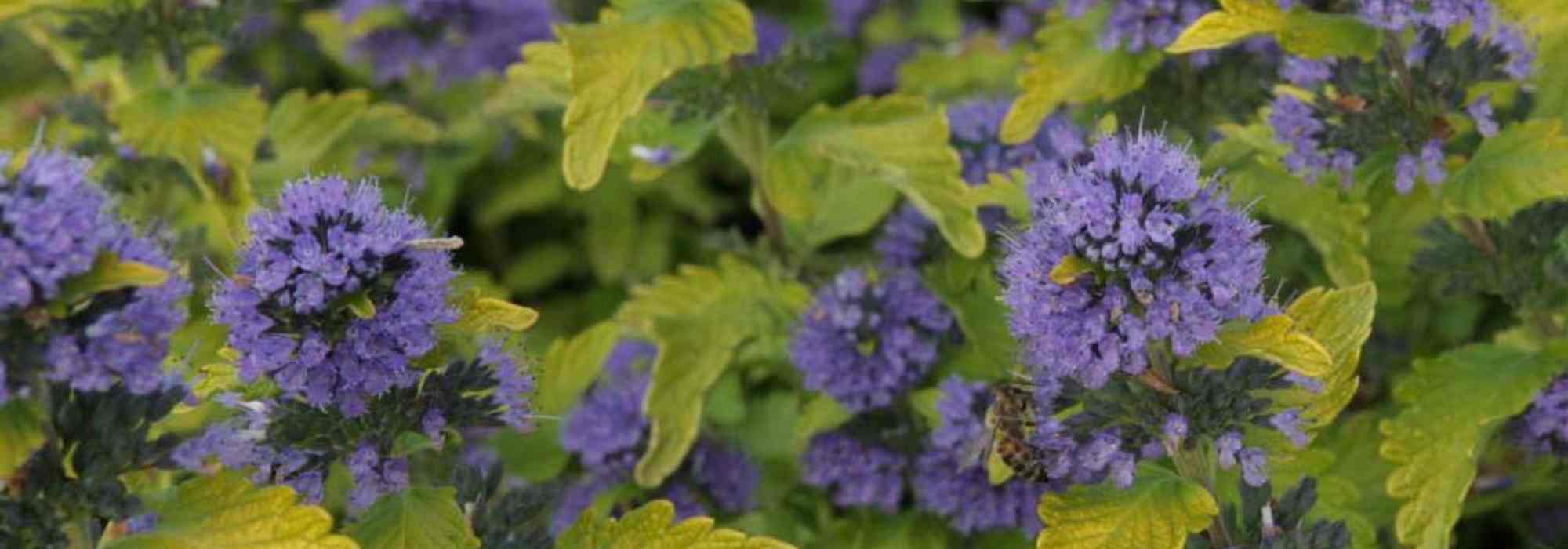
Choosing a Caryopteris
Discover our buying guide
Contents
Caryopteris, also known as ‘Bluebeard’ or ‘Blue Spiraea’, is a beautiful sun-loving bush, offering a splendid flowering from late summer, from August to October. The tips of its branches are covered with small flowers featuring long stamens, in blue or pink depending on the variety. Highly melliferous, it is a delight for both butterflies and the gardener’s eyes. Its surprising deciduous foliage is aromatic when crushed. Rather hardy, this bush is easy to grow in well-drained, even dry soil, and enjoys warmth. The blue spiraea is suitable for all uses: in rockeries, in a shrub border, as a specimen, in a pot on a terrace, or in a low hedge. There is a stunning range of varieties, with foliage in grey-green, golden yellow, or variegated. Discover our guide to help you choose a caryopteris based on its size, foliage, colour, and use.
Depending on the size of the bush
The caryopteris takes the form of a small shrub, well-ramified and bushy, with a height ranging from 45 cm to 1.50 m depending on the variety. Some spireas have a taller than wide habit, while others form a rounded ball. It is worth noting that the richness of the soil can increase the size of a specimen.
Small varieties, 45 to 75 cm tall:
Small caryopteris are ideal for pot cultivation or in a container on a sunny terrace or balcony. They will also enhance a rockery, as well as shrub or perennial plant beds. Here are a few:
- The Caryopteris clandonensis ‘Petit Bleu’ forms a compact bush of 60 cm in all directions. Its deciduous foliage is decorative, in grey-green tones. It offers clusters of small flowers in a magnificent intense blue.
- The Caryopteris clandonensis ‘Stephi’ is a very original variety as it offers abundant flowering in pale lilac pink tones. Rare for spireas, its flowers are slightly fragrant. It forms a bush 75 cm tall and 50 cm wide with grey-green foliage.
Medium varieties, 80 to 95 cm tall:
Medium-sized blue spireas are mainly used in rockeries, in pots, in beds alongside shrubs or perennials, but also in low hedges. Here is our selection :
- The Caryopteris clandonensis ‘Heavenly Blue’ forms a ramified, rounded, and vigorous bush of 80 cm in all directions. Its foliage is grey-green on top, while the underside is silver. Its flowering is a sublime blue-violet.
- The Caryopteris clandonensis ‘Pink Perfection’ offers tender pink flowering on a bush with grey-green leaves. It measures 80 cm to 1 m in all directions.
- The Caryopteris clandonensis ‘Blue Balloon’ is a bush of rounded shape, as its name suggests, reaching 80 cm in all directions.
- The Caryopteris ‘Summer Sorbet’ is much more spreading with its 1.20 m width for 80 cm height.
Large varieties, 1 m to 1.50 m:
The largest varieties of blue beard can also be planted in pots, but they are better suited for planting at the back of a bed, in isolation, or in a low hedge. Here are a few examples:
- The Caryopteris clandonensis ‘First Choice’ forms a lovely, bushy, very compact bush of 1 m in all directions. It offers flowering in intense blue tones, above grey-green foliage.
- The Caryopteris ‘Worcester Gold’ is a rather spreading variety with its 1.50 m width for 1 m height. It forms a bush with a compact habit, covered in golden green foliage and lavender blue flowers.
- The Caryopteris ‘Grand Bleu’ also forms a bush that is wider than it is tall. Bushy and rounded, it measures 1 m high and 1.50 m wide. Its foliage is silver-grey and its beautiful flowering is lavender blue.
- The Caryopteris clandonensis ‘Sterling Silver’ is one of the tallest varieties with its 1.20 m height for 90 cm width. It is splendid with its silver-grey foliage and intense blue-violet flowers.
Read also
How to take cuttings from Caryopteris?According to the colour of its flowers
Most varieties of spiraea bear flowers in shades of blue, varying in intensity, with lighter or purplish hues. However, there are a few rare spiraeas with pale pink flowers. Here are some remarkable ones:
Blue-flowered spiraeas:
Blue is the most common flowering colour for caryopteris. However, there are variations depending on the variety:
- Bright and deep blues: Caryopteris clandonensis ‘First Choice’, Caryopteris ‘White Surprise’, Caryopteris ‘Grand Bleu’, and Caryopteris ‘Petit Bleu’ offer intense blue flowering.
- Lavender blues: Caryopteris ‘Hint of Gold’, Caryopteris ‘Summer Sorbet’, as well as Caryopteris ‘Worcester Gold’.
- A surprising speckled blue: Caryopteris divaricata ‘Electrum’ is very original with its small blue flowers featuring a white throat, speckled with blue.
- Purple blues: Caryopteris clandonensis ‘Ferndown’, Caryopteris clandonensis ‘Sterling Silver’, and Caryopteris clandonensis ‘Heavenly Blue’.
Pink-flowered spiraeas:
Still relatively rare, varieties of caryopteris with pink flowers bring originality and a touch of softness to the garden. Here are our two favourite varieties:
- Caryopteris clandonensis ‘Pink Perfection’ offers the most tender pale pink flowering.
- Caryopteris clandonensis ‘Stephi’ is renowned for its abundant pale lilac pink flowering.
Discover other Caryopteris
View all →Available in 2 sizes
Available in 0 sizes
Available in 1 sizes
Available in 1 sizes
Available in 1 sizes
Available in 1 sizes
Available in 3 sizes
Available in 1 sizes
Available in 3 sizes
Available in 1 sizes
According to the colour of its foliage
Blue spireas have magnificent deciduous foliage, with colours ranging from grey-green to silver, dark green, golden, or variegated depending on the variety. Another unique feature is that the leaves are aromatic when crushed and release a pleasant scent of turpentine or a clever blend of anise and lavender. Here are some remarkable varieties:
- The Caryopteris clandonensis ‘Sterling Silver’ has bright foliage, with a silver-grey colour that exudes a scent of turpentine.
- The Caryopteris ‘Summer Sorbet’ features grey-green foliage, edged in yellow, adding a touch of sunshine to the garden.
- The Caryopteris ‘White Surprise’ is distinguished by its green foliage variegated with cream white, giving it a silver appearance.
- The Caryopteris ‘Hint of Gold’ is a remarkable bush due to its golden green foliage in early spring, which evolves into lemon green over the weeks. Its leaves release a pleasant scent of lavender and anise.
- The Caryopteris divaricata ‘Electrum’ is a rare and very original variety with its almond green foliage variegated with cream white.
- The Caryopteris ‘Worcester Gold’ brings brightness to the garden with its golden and lanceolate foliage.
- The Caryopteris clandonensis ‘Blue Balloon’ offers beautiful dark green foliage with a silver underside, which releases a pleasant balsamic scent when crushed.
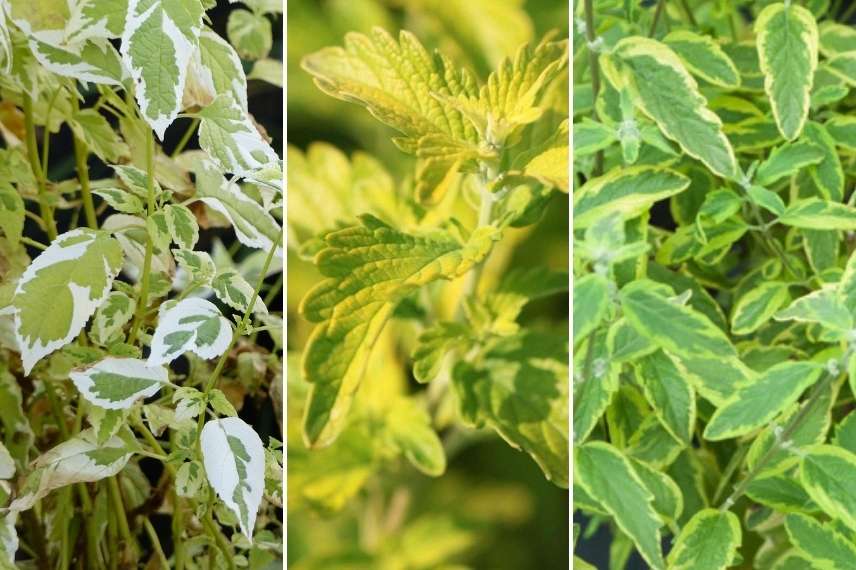
The magnificent foliage of Caryopteris divaricata ‘Electrum’, Caryopteris ‘Hint of Gold’, and Caryopteris ‘Summer Sorbet’
Read also
When and how to prune a Caryopteris?According to its hardiness
The blue spiraea is a sun-loving bush that thrives in warmth, in well-drained soil, even if dry and stony. Easy to grow, it is suitable for most regions, particularly south of the Loire. However, it is sensitive to stagnant moisture, especially in winter, which can lead to root rot.
The different varieties of caryopteris are all hardy down to -10 °C. Only a few cultivars are more hardy beyond that. Depending on your region and climate, this criterion may be crucial in your choice.
Caryopteris hardy down to -10 °C:
These varieties are hardy down to -10° C, and can withstand -12 to -15° C for very short periods, such as at the end of the night. They enjoy warmth and full sun, as well as occasional drought once well-rooted. In colder regions, they should be grown in pots and brought indoors during winter.
- The Caryopteris clandonensis ‘Heavenly Blue’ known for its stunning blue flowers.
- The Caryopteris clandonensis ‘Pink Perfection’ with its unique pink flowering.
- The Caryopteris clandonensis ‘Sterling Silver’ with its silver foliage.
- The Caryopteris ‘White Surprise’ with its green foliage edged in cream white.
- The Caryopteris clandonensis ‘Ferndown’ with its beautiful violet-blue flowers.
- The Caryopteris clandonensis ‘Stephi’ known for its abundant pink flowering.
Caryopteris hardy down to -15° C:
- The Caryopteris ‘Grand Bleu’ is one of the most common varieties, a reliable choice with blue flowers.
- The Caryopteris ‘Hint of Gold’ with its golden foliage in spring, turning to lemon green.
- The Caryopteris ‘Summer Sorbet’ appreciated for its green foliage edged in golden yellow.
- The Caryopteris ‘Worcester Gold’ with its beautiful golden foliage.
- The Caryopteris ‘Petit Bleu’ is one of the smallest varieties.
Caryopteris hardy beyond -15° C:
- The Caryopteris clandonensis ‘First Choice’ with its intense blue flowers.
- The Caryopteris clandonensis ‘Blue Balloon’ with its lovely rounded shape.
- The Caryopteris divaricata ‘Electrum’ is one of the most cold-resistant, but it will not appreciate the excess heat of the Mediterranean region.
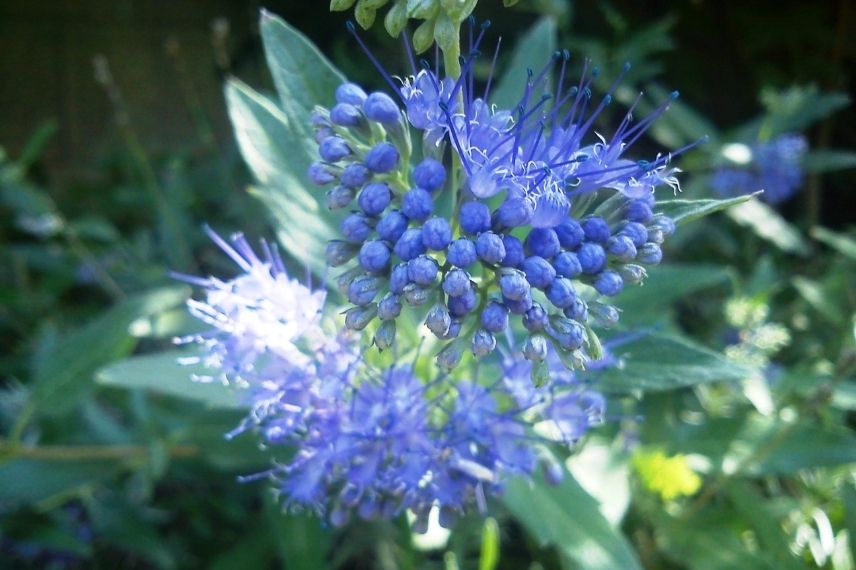
Caryopteris flowers
According to its use
Not exceeding 1.50 m in height, blue beard is a shrub that is perfectly suited for all uses. However, depending on the size, shape, or colour, some blue spireas will be better suited to your needs than others. Here are a few examples:
Smaller varieties of spireas will easily adapt to pot or container cultivation, thanks to their short stature, such as the Caryopteris clandonensis ‘Stephi’ or the Caryopteris ‘Petit Bleu’.
To create a low hedge, favour varieties that are taller than wide, such as the Caryopteris ‘Sterling Silver’, the Caryopteris ‘Hint of Gold’, the Caryopteris ‘First Choice’, or even the Caryopteris ‘White Surprise’.
To bring light and originality to a shrub bed, you can plant a Caryopteris ‘Summer Sorbet’, a Caryopteris ‘Blue Balloon’, a Caryopteris divaricata ‘Electrum’, or a Caryopteris ‘Stephi’ in a romantic garden.
In isolation or in a rockery, you can choose a variety that is wider than tall, such as the Caryopteris ‘Summer Sorbet’ or the Caryopteris clandonensis ‘Grand Bleu’.
For further reading
-
-
- Discover all our varieties of
-
- .
- To learn everything about caryopteris, find our tips on Blue Spirea: planting, pruning and care.
- Subscribe!
- Contents
![[Caryopteris-Choose]](https://en.promessedefleurs.eu/blogwp/wp-content/uploads/2021/09/Caryopteris-Choisir.jpg)






























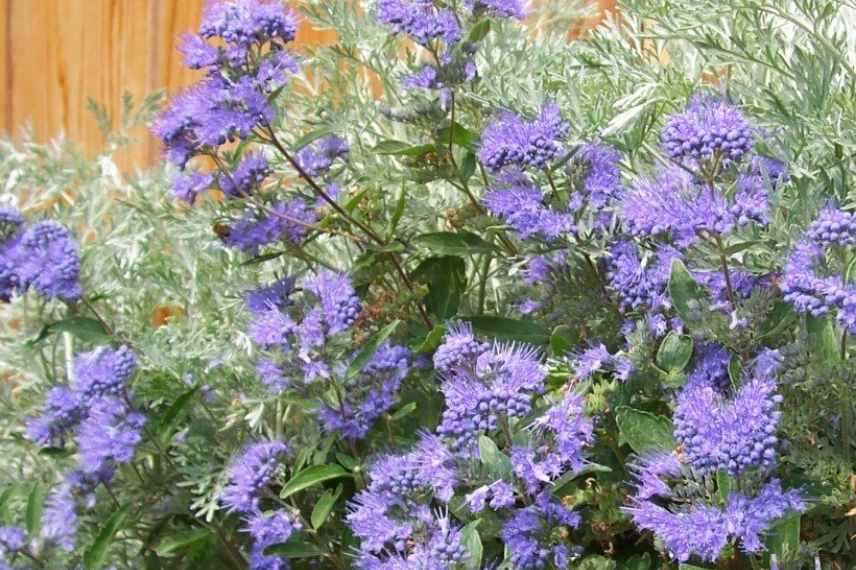

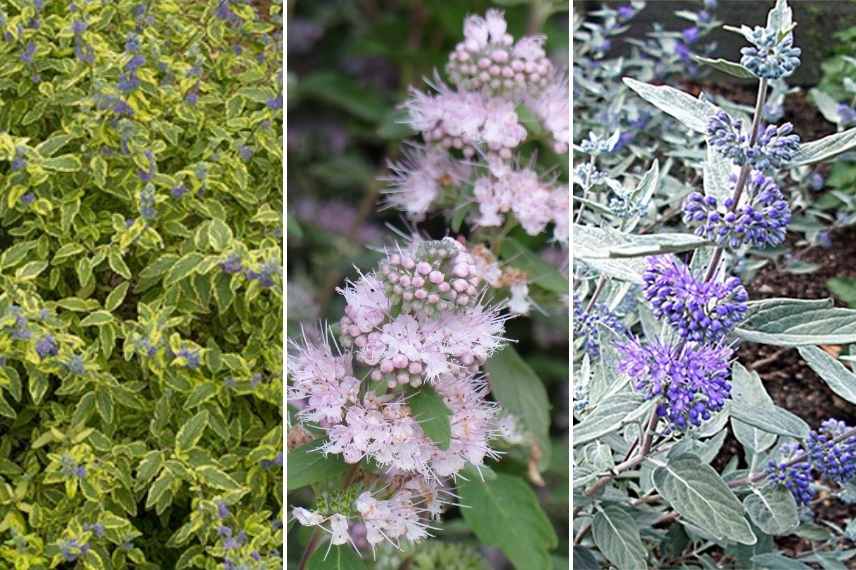
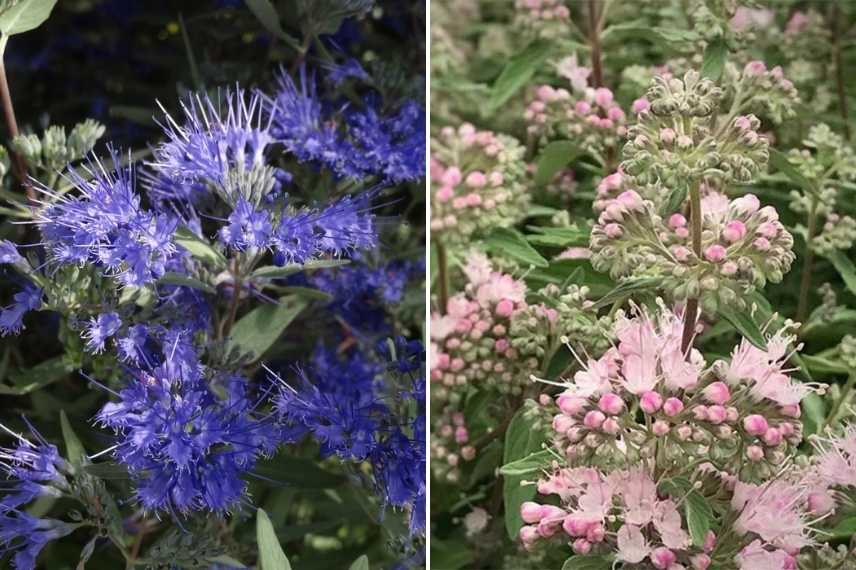
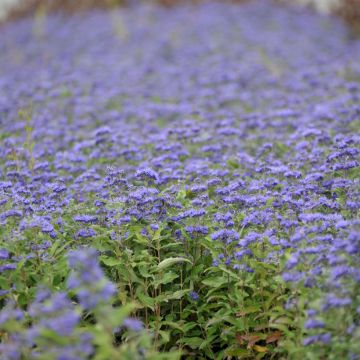
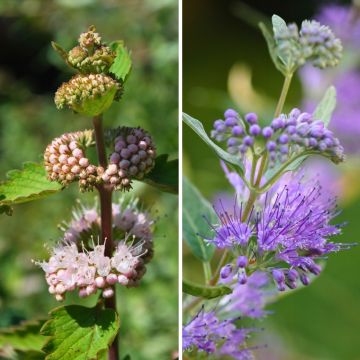
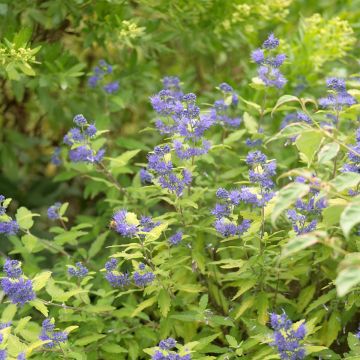
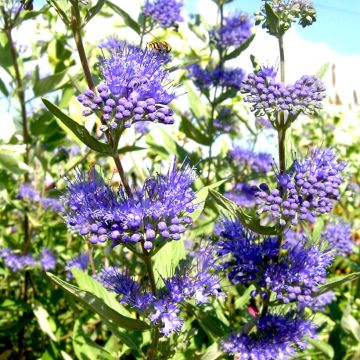
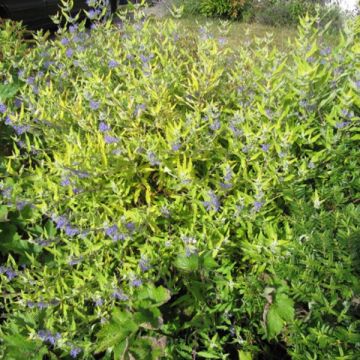
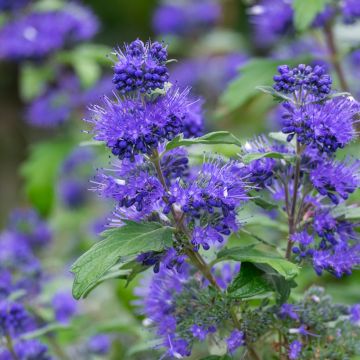
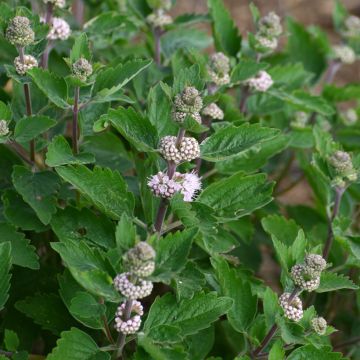
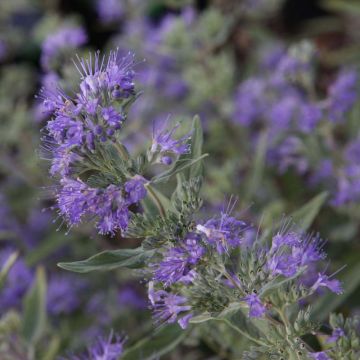
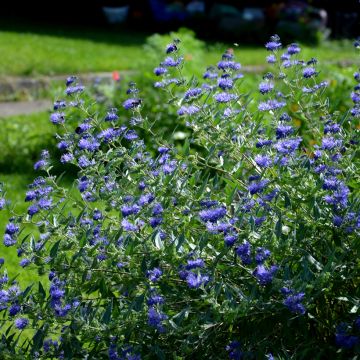
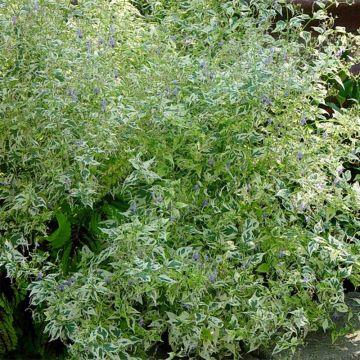
Comments